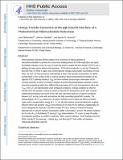| dc.contributor.author | Olshansky, Lisa | |
| dc.contributor.author | Stubbe, JoAnne | |
| dc.contributor.author | Nocera, Daniel | |
| dc.date.accessioned | 2017-07-18T20:08:49Z | |
| dc.date.issued | 2016 | |
| dc.identifier | Quick submit: 2017-05-11T13:44:38-0400 | |
| dc.identifier.citation | Olshansky, Lisa, JoAnne Stubbe, and Daniel G. Nocera. 2016. “Charge Transfer Dynamics at the α/β Subunit Interface of a Photochemical Ribonucleotide Reductase.” Journal of the American Chemical Society 138 (4) (February 3): 1196–1205. doi:10.1021/jacs.5b09259. | en_US |
| dc.identifier.issn | 0002-7863 | en_US |
| dc.identifier.uri | http://nrs.harvard.edu/urn-3:HUL.InstRepos:33464251 | |
| dc.description.abstract | Ribonucleotide reductase (RNR) catalyzes the conversion of ribonucleotides to deoxyribonucleotides to provide the monomeric building blocks for DNA replication and repair. Nucleotide reduction occurs by way of multi-step proton-coupled electron transfer (PCET) over a pathway of redox active amino acids spanning ~ 35 Å and two subunits (α2 and β2). Despite the fact that PCET in RNR is rapid, slow conformational changes mask kinetic examination of these steps. As such, we have pioneered methodology in which site-specific incorporation of a [ReI] photooxidant on the surface of the β2 subunit (photoβ2) allows photochemical oxidation of the adjacent PCET pathway residue β-Y356 and time-resolved spectroscopic observation of the ensuing reactivity. A series of photoβ2s capable of performing photoinitiated substrate turnover have been prepared in which four different fluorotyrosines (FnYs) are incorporated in place of β-Y356. The FnYs are deprotonated under biological conditions, undergo oxidation by electron transfer (ET) and provide a means by which to vary the ET driving force (ΔG°) with minimal additional perturbations across the series. We have used these features to map the correlation between ΔG° and kET both with and without the fully assembled photoRNR complex. The photooxidation of FnY356 within the α/β subunit interface occurs within the Marcus inverted region with a reorganization energy of λ ≈ 1 eV. We also observe enhanced electronic coupling between donor and acceptor (HDA) in the presence of an intact PCET pathway. Additionally, we have investigated the dynamics of proton transfer (PT) by a variety of methods including dependencies on solvent isotopic composition, buffer concentration, and pH. We present evidence for the role of α2 in facilitating PT during β-Y356 photooxidation; PT occurs by way of readily exchangeable positions and within a relatively “tight” subunit interface. These findings show that RNR controls ET by lowering λ, raising HDA, and directing PT both within and between individual polypeptide subunits. | en_US |
| dc.description.sponsorship | Chemistry and Chemical Biology | en_US |
| dc.language.iso | en_US | en_US |
| dc.publisher | American Chemical Society (ACS) | en_US |
| dc.relation.isversionof | 10.1021/jacs.5b09259 | en_US |
| dc.relation.hasversion | https://www.ncbi.nlm.nih.gov/pmc/articles/PMC4924928/ | en_US |
| dash.license | OAP | |
| dc.title | Charge Transfer Dynamics at the α/β Subunit Interface of a Photochemical Ribonucleotide Reductase | en_US |
| dc.type | Journal Article | en_US |
| dc.date.updated | 2017-05-11T17:44:06Z | |
| dc.description.version | Accepted Manuscript | en_US |
| dc.relation.journal | Journal of the American Chemical Society | en_US |
| dash.depositing.author | Nocera, Daniel | |
| dc.date.available | 2016 | |
| dc.date.available | 2017-07-18T20:08:49Z | |
| dc.identifier.doi | 10.1021/jacs.5b09259 | * |
| dash.contributor.affiliated | Olshansky, Lisa | |
| dash.contributor.affiliated | Nocera, Daniel | |


